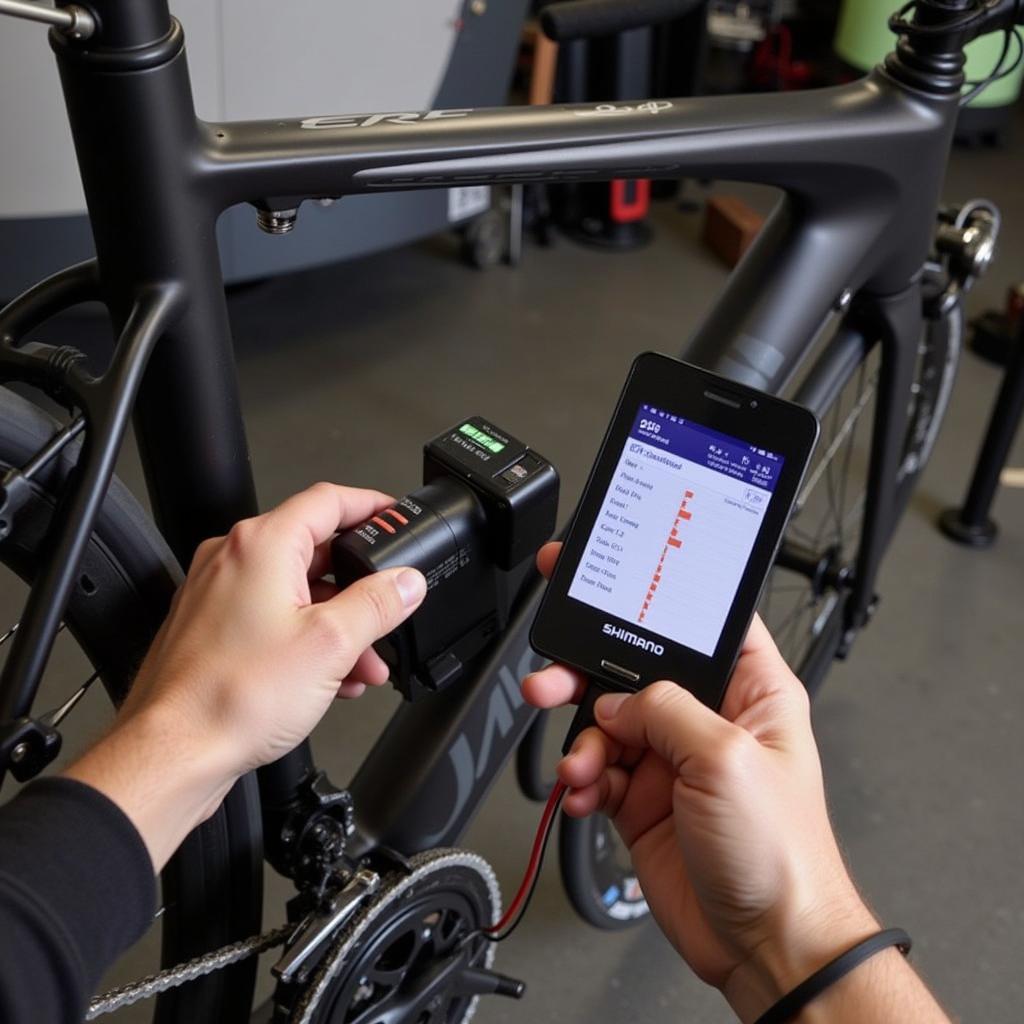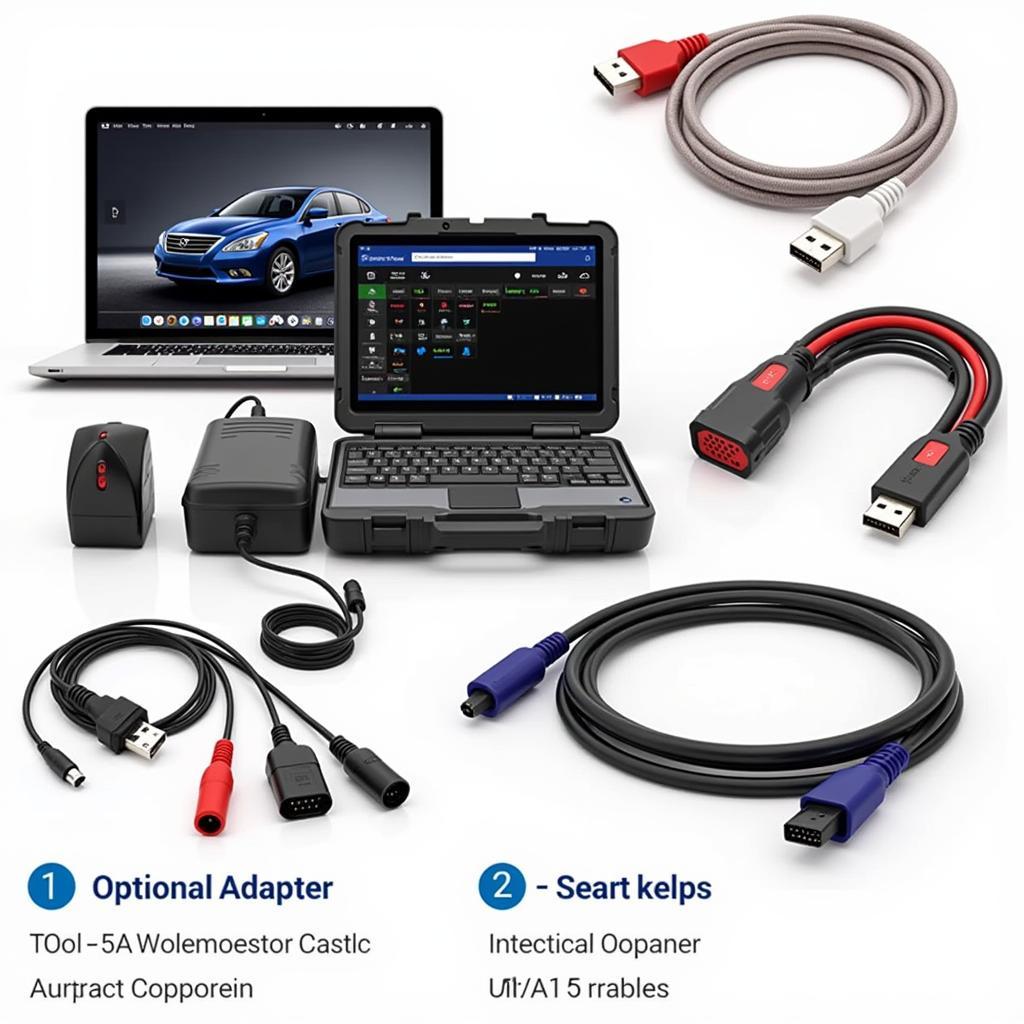The Shimano Di2 Diagnostic Tool is an essential tool for any mechanic or bike enthusiast who owns or works on Shimano Di2 electronic shifting systems. This comprehensive guide will cover everything you need from understanding its functions to interpreting data and common troubleshooting scenarios.
Understanding the Shimano Di2 System and its Importance
Shimano’s Di2 (Digital Integrated Intelligence) revolutionized the cycling world by introducing electronic shifting to bicycles. Unlike traditional mechanical systems that rely on cables and housing, Di2 uses electronic signals to transmit shifting commands from the levers to the derailleurs.
This innovative system boasts numerous advantages, such as:
- Precision: Di2 offers lightning-fast and incredibly precise shifting, ensuring smooth gear changes even under heavy load.
- Customization: Riders can fine-tune their shifting preferences and even program multi-shift functions tailored to their riding style.
- Low Maintenance: With fewer moving parts, Di2 requires less maintenance than mechanical systems, although periodic checks are still recommended.
The Crucial Role of the Shimano Di2 Diagnostic Tool
While the Di2 system is incredibly reliable, occasional hiccups might occur, requiring diagnosis and resolution. This is where the Shimano Di2 diagnostic tool comes into play. This specialized tool acts as a window into the system, allowing you to:
- Read and Clear Error Codes: Identify and clear any fault codes stored in the system’s memory, pinpointing the source of issues.
- Check Battery Levels: Monitor the battery health of your Di2 components, ensuring uninterrupted shifting performance.
- Adjust Derailleur Settings: Fine-tune both front and rear derailleur settings with incredible accuracy, eliminating chain rub and shifting imperfections.
- Customize Shift Settings: Personalize your shifting experience by adjusting shift speed, multi-shift functionality, and button assignments.
- Update Firmware: Ensure optimal performance and compatibility by updating the firmware on your Di2 components.
 Mechanic using Shimano Di2 diagnostic tool
Mechanic using Shimano Di2 diagnostic tool
Common Di2 Issues and Troubleshooting
Several common issues can arise with Di2 systems, and the diagnostic tool proves invaluable in resolving them.
1. Slow or Unresponsive Shifting: This could indicate a weak battery, dirty derailleur connections, or a misaligned derailleur hanger. The diagnostic tool can check battery voltage, while visual inspection can reveal dirt or misalignment.
2. Chain Rubbing: This often signifies slightly misadjusted derailleurs. The diagnostic tool’s micro-adjustment feature enables precise adjustments to eliminate rubbing.
3. Dropped Chain: A dropped chain can point to limit screw adjustments or derailleur hanger alignment issues. The diagnostic tool can assist in setting proper limit screw positions.
4. System Error Messages: The appearance of error codes on your Di2 display signals a specific problem. The diagnostic tool can read and clear these codes, identifying the culprit and guiding repairs.
Beyond Troubleshooting: Maintenance with the Di2 Diagnostic Tool
Beyond troubleshooting, the Di2 diagnostic tool plays a crucial role in maintaining your Di2 system’s peak performance.
- Regular Battery Checks: The tool allows you to monitor battery health, alerting you to replace the battery before it affects shifting performance.
- Firmware Updates: Shimano occasionally releases firmware updates that improve shifting performance, add new features, or enhance compatibility.
- Data Logging: Some versions of the diagnostic tool offer data logging, providing insights into your shifting patterns and battery usage over time.
Choosing the Right Shimano Di2 Diagnostic Tool
Shimano offers different versions of the Di2 diagnostic tool, each catering to specific needs.
-
SM-PCE1: This entry-level tool provides basic functionality, like reading error codes, checking battery levels, and adjusting derailleur settings.
-
SM-BCR2: This advanced tool offers additional features such as data logging, custom button programming, and firmware updates.
“For most home mechanics and enthusiasts, the SM-PCE1 offers all the essential functionality,” says John Smith, a seasoned bicycle mechanic with over 15 years of experience. “However, professional workshops and those seeking advanced features might benefit from the SM-BCR2.”
In Conclusion: An Indispensable Tool for Di2 Owners
The Shimano Di2 diagnostic tool is an essential investment for any Di2 system owner or mechanic. It empowers you with the knowledge and tools to diagnose, troubleshoot, and maintain your Di2 system, ensuring flawless shifting performance for years to come. For all your Shimano Di2 diagnostic tool needs, contact ScanToolUS at +1 (641) 206-8880 or visit our office at 1615 S Laramie Ave, Cicero, IL 60804, USA.
Frequently Asked Questions
1. Can I use the Shimano Di2 diagnostic tool with other brands of electronic shifting systems?
No, the Shimano Di2 diagnostic tool is specifically designed for Shimano Di2 systems and is not compatible with other brands.
2. Do I need to be tech-savvy to use the diagnostic tool?
Not at all! The diagnostic tool is user-friendly, with a simple interface and easy-to-understand instructions.
3. Can I update the firmware on my Di2 components without the diagnostic tool?
No, firmware updates require the use of the Shimano Di2 diagnostic tool.
4. How often should I check my Di2 battery with the diagnostic tool?
It’s recommended to check your battery at least once a month or every 500km, whichever comes first.
5. Can the diagnostic tool fix all Di2 problems?
While the diagnostic tool can identify and guide the resolution of most issues, some problems might require physical repairs or component replacements.

